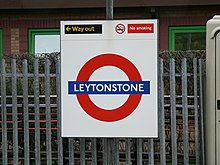| Revision as of 09:08, 2 July 2008 editKbthompson (talk | contribs)40,503 edits Undid revision 222969992 by 92.3.34.90 (talk) - long commute from Boston← Previous edit | Revision as of 18:51, 12 July 2008 edit undoCheckeroffacts (talk | contribs)80 edits →Notable people associated with Leytonstone: remove uncitedNext edit → | ||
| Line 61: | Line 61: | ||
| *] | *] | ||
| *] | *] | ||
| *]{{Fact|date=June 2008}} | |||
| *] | *] | ||
| *] | *] | ||
Revision as of 18:51, 12 July 2008
Human settlement in EnglandLeytonstone is a place in the London Borough of Waltham Forest, in East London, England.
History
The main thoroughfare in Leytonstone, High Road Leytonstone, which runs the length of Leytonstone to Stratford is an ancient pathway dating to pre-Roman times. Roman archaeological features have been found in the area.
The name Leytonstone - in early documents Leyton-Atte-Stone - may derive from the large stone standing at the junction of Hollybush Hill and New Wanstead; in the 18th-century an obelisk was mounted on top of it, and it has been claimed that it is the remains of a Roman milestone.
Two of the obelisk's inscriptions are still just legible: others are not.
- "To Epping XI Miles through Woodford, Loughton"
- "To Ongar XV Miles through Woodford Bridge, Chigwell, Abridge"
It has been claimed that High Road Leytonstone is a prehistoric pathway dating from before the Romans built a road along the same route to London. However Roman roads have since been found during excavations.
The earliest known cartographic reference to Leytonstone is dated from 1545. It was part of Essex until 1965.
To the eastern side of Leytonstone lies the Lake House estate, which until its recent inclusion within the London Borough of Redbridge was also seen as belonging to the area.
Leytonstone was the centre of protests against the construction of the M11 link road, in 1990. The protesters' final stand was staged at Claremont Road, Leytonstone and was ended by the forced eviction of protestors in 1994.
Education
The borough includes the prestigious girls' school Connaught School for Girls, which is now a specialist Language College, and also Leytonstone School which is a specialist school in business and enterprise.
Notable features
- Epping Forest boundaries reach Leytonstone in wooded areas called Hollow Ponds and Wanstead Flats.
- Whipps Cross University Hospital
- Dagenham & Redbridge football club, currently a professional Coca-Cola League Two team, is an amalgamation of several amateur football clubs, including Leytonstone F.C., who played along Leytonstone High Road. The Wanderers F.C. also originated from Leytonstone but played in several other venues round London.
Notable people associated with Leytonstone

- Alfred Hitchcock was born and raised in the area; the entrance to Leytonstone tube station has a number of mosaics depicting scenes from his films.
- One infamous person who reputedly passed through Leytonstone, staying at the Green Man pub (now O'Neill's), was Essex-born highwayman Dick Turpin. Turpin allegedly passed through Leytonstone to Epping Forest en route to Norwich, and eventually to his appointment with the hangman in 1739.
- Damon Albarn, singer-songwriter and musician (keyboard, piano, ...) with Blur, Gorillaz and The Good The Bad And The Queen.
- David Beckham
- Boy Kill Boy
- Cornelius Cardew
- Eamon Everall
- Fanny Craddock
- Curtis Davies
- John Drinkwater
- Ken Farnes
- Joanne Fenn
- Graham Gooch
- Steve Harris
- Sydney Horler
- Justin Hoyte
- Derek Jacobi
- Colin Kazim-Richards
- Natasha Little
- Morell Mackenzie
- Tony Robinson
- Jonathan Ross and his brother Paul Ross
- June Sarpong
- Rita Simons
- Talvin Singh
- Meera Syal
- Sean MacStiofain
Transport and locale
Nearby places
Nearest tube station
Nearest railway station
| London Borough of Waltham Forest | ||
|---|---|---|
| Districts |
|   |
| Attractions | ||
| Street markets | ||
| Parks and open spaces | ||
| Constituencies |
| |
| Tube and rail stations | ||
| Other topics | ||
References
http://www.wansteadwildlife.org.uk/INTRODUCTORY_AND_VARIOUS_FILES/about_Wanstead_Wildlife.htm
- http://www.wansteadwildlife.org.uk/INTRODUCTORY_AND_VARIOUS_FILES/about_Wanstead_Wildlife.htm. Retrieved 2008-05-10.
{{cite web}}: Missing or empty|title=(help)